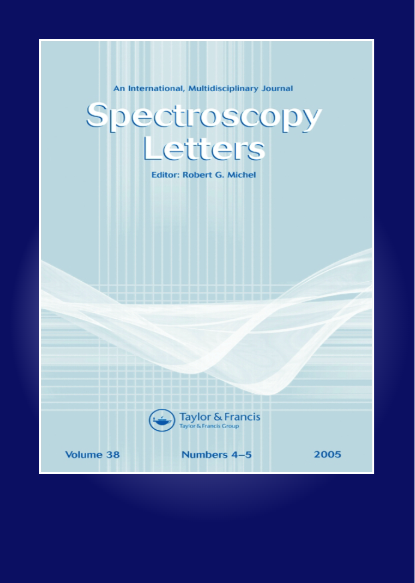Vibrational spectral and electronic properties, Topology studies and biological assay of a potent Anticonvulsant agent: Divalproex Sodium
IF 1.6
4区 化学
Q3 SPECTROSCOPY
引用次数: 0
Abstract
Abstract In this research work, Density Functional Theory based computational analysis on the molecular structure of Divalproex Sodium was carried out in the gas phase. Comprehensive analysis of vibrational spectra, Proton and Carbon Nuclear Magnetic Resonance, and electronic absorption spectrum have been carried out and the findings were compared to those obtained using computational techniques. The electronic transport properties were studied by the Ultraviolet-Visible spectrum obtained in distinct solvents by Time Dependent-Density Functional Theory method. Also, inter and intra-molecular interactions and charge transfer activity within the system were studied by Natural Bond Orbital and Frontier Molecular Orbital analyses. For the Non-Linear Optical profile of the compound, hyperpolarizability calculations were performed. The chemical reactivity of the investigated substance has also been disclosed by reactivity descriptors. The biological assessment through drug-likeness characteristics and molecular docking studies was performed to find the compound as anticonvulsant drugs. Highlights Optimized geometrical parameters were computed Vibrational, Electronic, and NMR spectra have been analyzed. Stability and chemical reactivity were studied. Inter/intramolecular interactions have been observed. Pharmacological activities were reported.一种强效抗惊厥剂:二伏罗钠的振动光谱和电子性质、拓扑结构研究和生物测定
摘要在本研究工作中,基于密度泛函理论对Divalproex钠在气相中的分子结构进行了计算分析。对振动光谱、质子和碳核磁共振以及电子吸收光谱进行了综合分析,并将这些发现与使用计算技术获得的结果进行了比较。利用时间相关密度泛函理论方法,在不同溶剂中获得紫外可见光谱,研究了电子输运性质。此外,通过自然键轨道和前沿分子轨道分析研究了系统内分子间和分子内的相互作用以及电荷转移活性。对于该化合物的非线性光学轮廓,进行了超极化率计算。所研究物质的化学反应性也已通过反应性描述符公开。通过药物相似性特征和分子对接研究进行生物学评估,以寻找该化合物作为抗惊厥药物。亮点计算了优化的几何参数,分析了振动、电子和核磁共振光谱。研究了稳定性和化学反应性。已经观察到分子间/分子内的相互作用。报道了药理活性。
本文章由计算机程序翻译,如有差异,请以英文原文为准。
求助全文
约1分钟内获得全文
求助全文
来源期刊

Spectroscopy Letters
物理-光谱学
CiteScore
2.90
自引率
5.90%
发文量
50
审稿时长
1.3 months
期刊介绍:
Spectroscopy Letters provides vital coverage of all types of spectroscopy across all the disciplines where they are used—including novel work in fundamental spectroscopy, applications, diagnostics and instrumentation. The audience is intended to be all practicing spectroscopists across all scientific (and some engineering) disciplines, including: physics, chemistry, biology, instrumentation science, and pharmaceutical science.
 求助内容:
求助内容: 应助结果提醒方式:
应助结果提醒方式:


